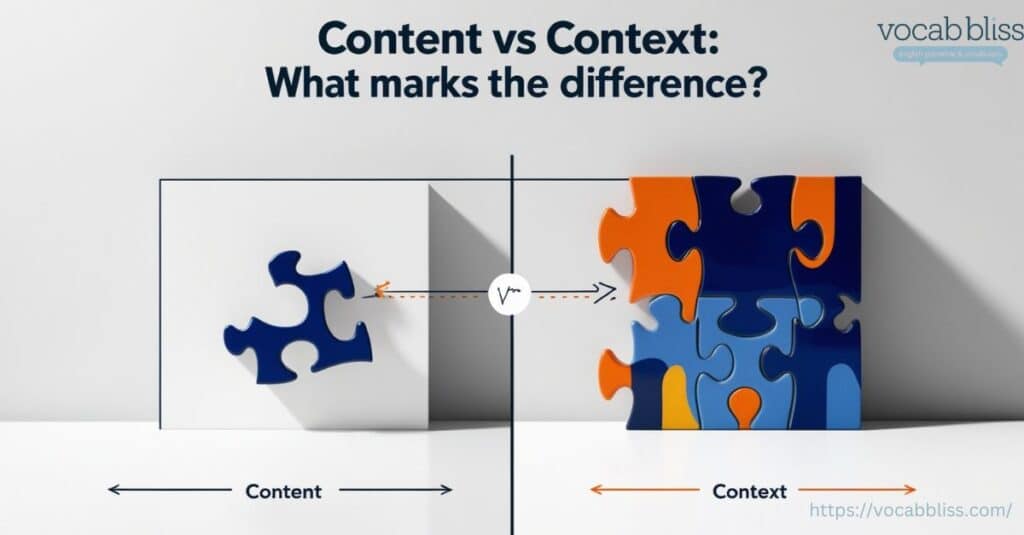When it comes to effective communication, the terms content vs context often surface as critical components. These two concepts are interconnected, but they represent entirely different aspects of conveying a message.
To understand their importance, let’s delve into their meanings, roles, and how they work together to ensure successful communication.
Quick Summary
The difference between content vs context lies in their roles in communication. Content conveys the actual message, material, or information, while context provides the environment or circumstances that give the message its meaning. Without context, content can be misinterpreted or lose its relevance. Together, they shape effective communication by ensuring that the message is both clear and impactful. Whether crafting a marketing campaign, writing a blog, or engaging in a conversation, balancing content with context ensures that the intended audience understands and connects with your message.
Explore further: Hustle or Hussle: Which Spelling is Correct?
Why the Confusion Between Content and Context?
The confusion between context and content stems from their close relationship. Both are essential for crafting meaningful communication, yet they serve different purposes.
- Content refers to the message itself — the words, images, or sounds you use to communicate.
- Context, on the other hand, provides the circumstances or background that shape the interpretation of that message.
Without understanding both, communication risks falling flat or being misunderstood.
What is Content?
To clarify, content refers to the actual material or substance of a message—what is being communicated. It encompasses the ideas, information, and meaning conveyed to the audience, whether through text, images, videos, or other media. Simply put, content is the “what” in communication.
For example:
- A blog post sharing tips on healthy eating is content.
- A graphic illustrating steps to cook a meal is content.
- A podcast discussing mental health is also content.
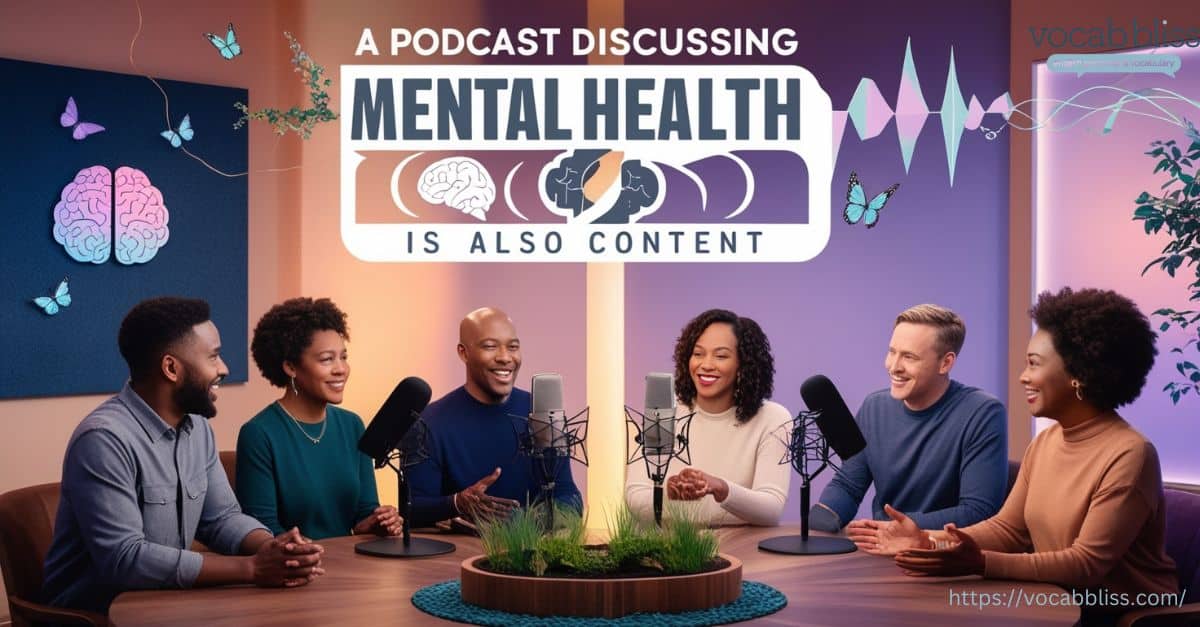
Types of Content
Content takes many forms, depending on the medium and the audience. Below is an overview of key content types:
| Type | Definition | Examples |
|---|---|---|
| Written | Text-based material | Blog posts, articles, reports |
| Visual | Image-based or graphic content | Infographics, photos, illustrations |
| Audio | Sound-based material | Podcasts, audiobooks, interviews |
| Interactive | Content that requires user engagement | Quizzes, calculators, games |
| Video | Moving visual content | Tutorials, vlogs, commercials |
Characteristics of Effective Content
- Relevance: Content should meet the audience’s needs or interests.
- Clarity: The message must be easy to understand and free of unnecessary jargon.
- Engagement: High-quality content grabs and retains attention.
- Actionable: The best content inspires the audience to think, act, or make decisions.
- Adaptability: Great content aligns with the platform delivering it, whether it’s social media, blogs, or emails.
The Role of Content in Communication
Content is the core of any communication effort. It provides the information, ideas, or emotions that the sender wants to share. However, content alone is not enough—its effectiveness depends on how well it fits the context.
For example:
- A heartfelt story (content) in an email may resonate with readers during a charitable fundraiser (context).
- Conversely, a professional pitch deck that prioritizes brevity and data might make that same story fall flat.
How Content Shapes Meaning
Content plays a significant role in determining how a message is perceived:
- Informational Content: Provides knowledge (e.g., “5 Ways to Save Money”).
- Emotional Content: Evokes feelings (e.g., a video showcasing a reunion).
- Persuasive Content: Encourages action (e.g., “Buy One, Get One Free”).
Examples of High-Impact Content
- Social Media Campaigns: A well-crafted Instagram post with engaging visuals and a concise caption drives user interaction.
- Educational Videos: Tutorials simplify complex topics, like learning software tools.
- User-Generated Content: Reviews, testimonials, or photos shared by customers create trust and authenticity.
What is Context?
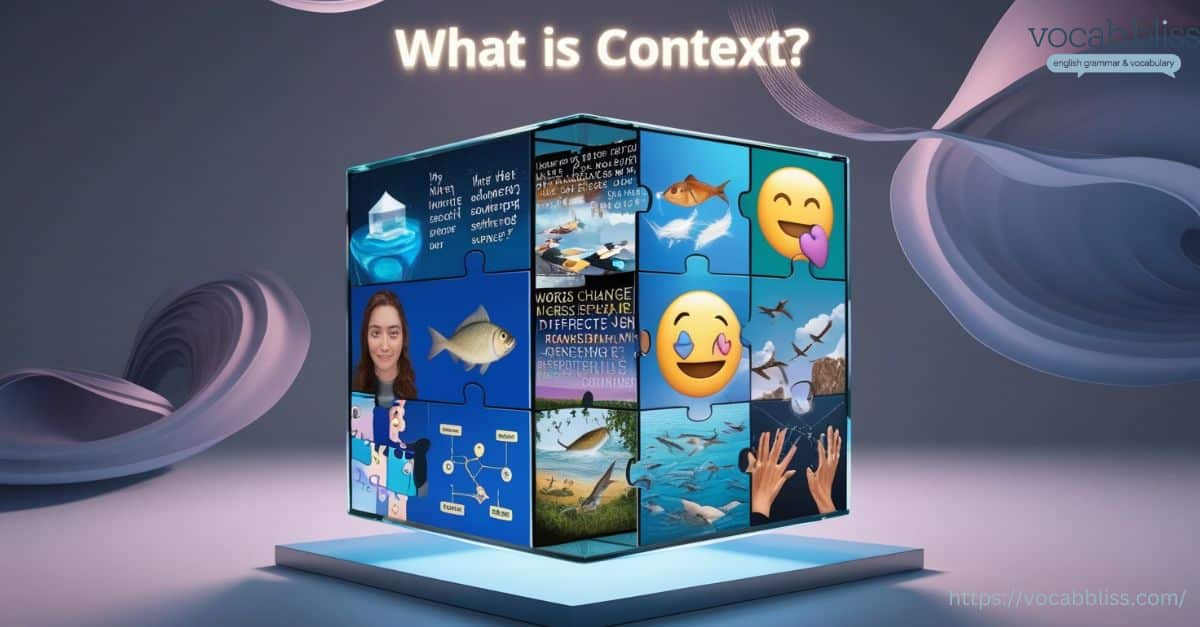
The background, environment, or circumstances significantly influence how a message is understood, ultimately forming its context. In other words, it acts as the “setting” in which communication occurs, thereby providing the necessary clues for interpreting the message correctly.
In simple terms, context answers the who, what, where, when, why, and how of communication. It shapes how the audience perceives the content, adding depth and meaning to it.
Types of Context
Different forms of context can affect the interpretation of a message. Here are some of the most significant ones:
| Type | Definition | Example |
|---|---|---|
| Historical Context | The influence of past events on understanding | A speech referencing World War II history |
| Cultural Context | Social norms, traditions, and shared values | A joke relying on specific cultural humor |
| Situational Context | The immediate environment or circumstances | Formal language used during a job interview |
| Social Context | Roles and relationships among people communicating | Informal tone with close friends |
Why is Context Important?
Context is essential because it ensures the message is interpreted as intended. Without context, communication risks misunderstanding, confusion, or even offense.
For instance:
- The phrase “I’m fine” could mean different things in a heated argument versus a casual conversation.
- An email sent with a serious tone might seem overly harsh if the recipient expected a lighthearted approach.
The Role of Context in Communication
- Clarity: Context helps eliminate ambiguity, making the message clearer.
- Relevance: It aligns the message with the audience’s expectations and needs.
- Impact: A message that fits the context leaves a stronger impression.
Examples of Context Shaping Content
- Advertising: A soft drink ad during summer emphasizes refreshment, while marketers promote the same drink as nostalgic during the holiday season.
- Education: A teacher adjusts their explanation of a topic based on students’ prior knowledge and cultural backgrounds.
- Media: News outlets frame stories differently based on the cultural or political context of their audience.
Key Differences Between Content and Context
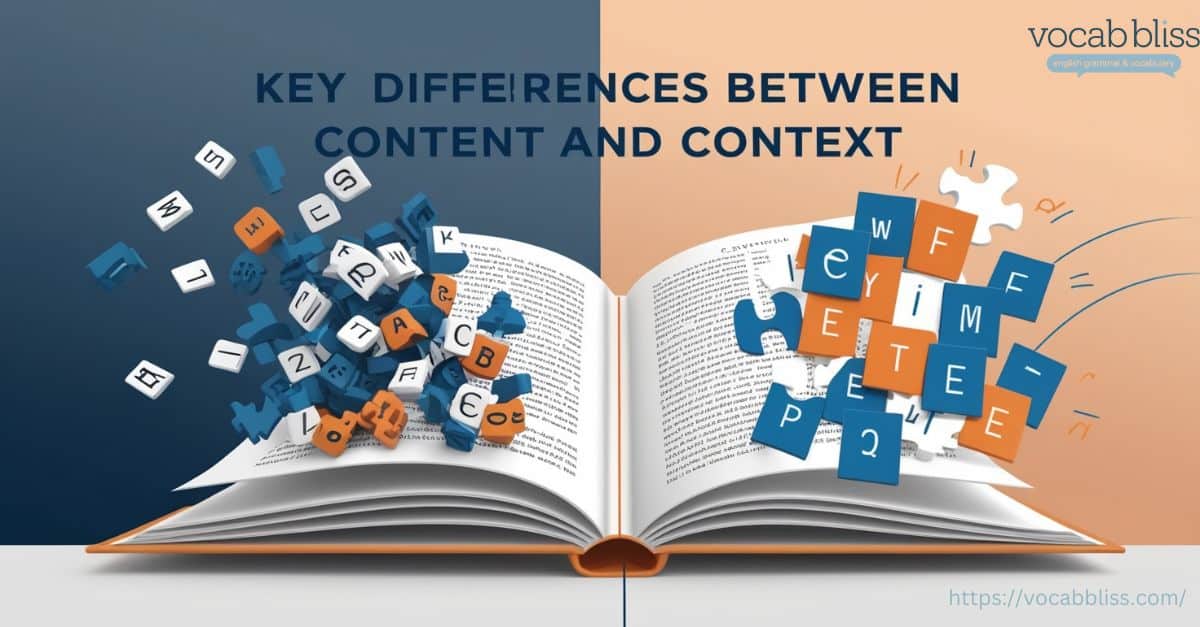
While context and content are interrelated, they serve distinct purposes in communication. Content is the core material or message, while context provides the backdrop that shapes its interpretation.
Understanding these differences is essential for crafting meaningful and impactful communication.
| Aspect | Content | Context |
|---|---|---|
| Definition | The actual message or material being conveyed. | The circumstances or environment in which the message is delivered. |
| Focus | What is being said or shared. | How, where, and why the message is interpreted. |
| Examples | A written article, an image, or a video. | The cultural, social, or situational factors affecting interpretation. |
| Purpose | To deliver information, emotion, or a call to action. | To clarify, enhance, or influence how the message is received. |
| Flexibility | Fixed—content remains the same regardless of where it’s presented. | Dynamic—context changes based on environment, audience, or timing. |
| Dependency | Exists independently as the core material. | Relies on the content to provide meaning. |
| Impact on Communication | Provides the primary message. | Shapes the message’s perception and relevance. |
Key Points of Difference
Content Is the “What,” Context Is the “Why” and “How”
- Content is the substance: the blog post, speech, or artwork.
- Context is the setting that makes the substance meaningful.
For example:
A joke (content) may be humorous at a comedy club but inappropriate in a solemn meeting (context).
Content Relies on Context for Meaning
Without context, even the most well-crafted content can lead to miscommunication.
Example:
The communicator can interpret the phrase “That’s great!” as genuine praise or sarcasm, depending on their tone, environment, and relationship with the audience. For example, a cheerful tone might suggest praise, while a flat or exaggerated tone could indicate sarcasm. Additionally, the context of the conversation and the history between the communicator and the audience also play crucial roles in shaping the interpretation.
Static Content vs. Dynamic Context
- Content is often static, meaning it doesn’t change regardless of its environment.
- Context is dynamic and evolves based on audience, timing, and platform.
Case Study:
An ad campaign with vibrant imagery and slang-heavy captions (content) might succeed on Instagram but fail on LinkedIn, where the context demands professionalism.
Why Understanding the Differences Matters
- Improves Communication: Knowing the distinction ensures your message is clear and relevant.
- Avoids Misunderstanding: Aligning content with its context minimizes confusion.
- Enhances Engagement: When the two work together, communication becomes impactful.
Quote to Remember
“Content is king, but context is its kingdom.”
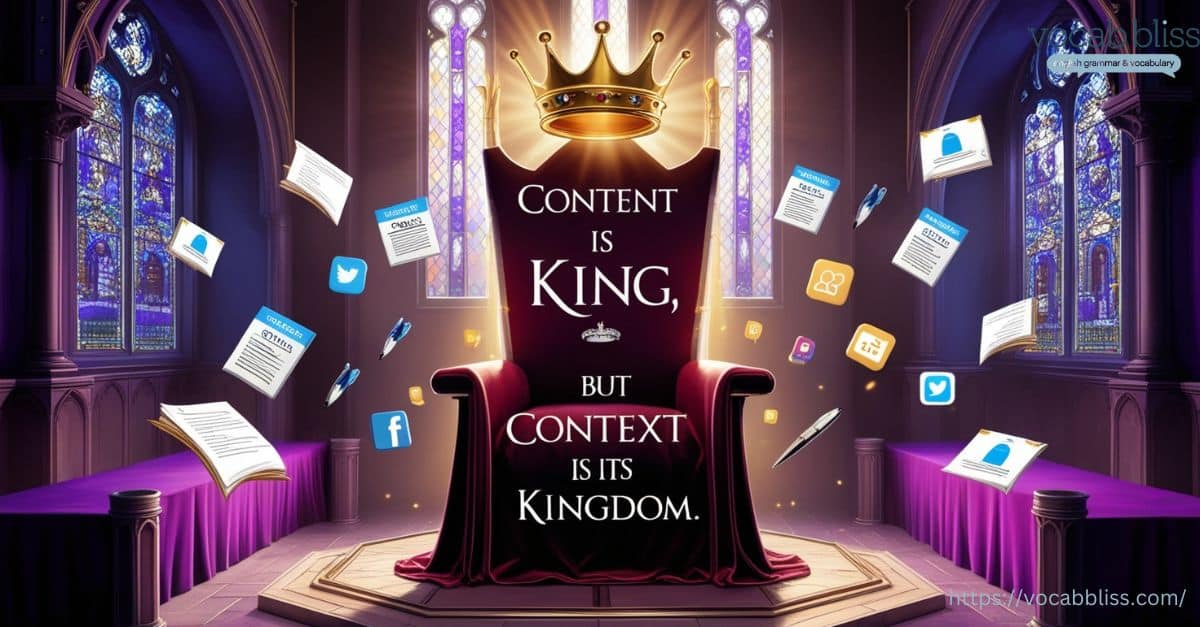
Why Content Alone Isn’t Enough
Examples of Miscommunication Due to Lack of Context
Consider a joke shared on social media:
- Without understanding the cultural or situational context, the joke might offend or confuse the audience.
Importance of Context in Marketing, Education, and Communication
Context enhances engagement by tailoring the message to the audience’s needs. For example:
- Marketing: Understanding consumer behavior ensures the right tone and timing.
- Education: Students grasp concepts better when lessons are contextualized.
Why Content Alone Isn’t Enough
While content forms the foundation of communication, it cannot achieve its full potential without the right context. Content delivers the message, but context ensures the message is understood, relevant, and impactful.
Imagine delivering a powerful speech to an audience that doesn’t speak your language. Even though the content may be great, the lack of context, consequently, renders it meaningless.
The Limits of Content Without Context
| Limitation | Explanation | Example |
|---|---|---|
| Misinterpretation | Content without context can be misunderstood. | A sarcastic text message may be taken literally without tone or facial cues. |
| Lack of Relevance | Content alone may not resonate with the audience. | A technical article may fail to engage beginners if written with jargon. |
| Missed Engagement | Context determines whether the audience connects emotionally. | A heartfelt story might fall flat if shared at the wrong time. |
| Failure to Inspire Action | Context motivates action by aligning the message with the audience’s needs. | A sales pitch might fail if it doesn’t consider the audience’s current challenges. |
Content vs Context Real-World Examples
Marketing Campaigns Gone Wrong:
A luxury brand’s ad showcasing opulence might seem tone-deaf during an economic recession. While the content may be visually appealing, the context of financial struggles makes it inappropriate.
Cultural Missteps:
A global company using a slogan that translates poorly into another language. For instance, KFC’s “Finger-Lickin’ Good” translated to “Eat Your Fingers Off” in Chinese—content failing without contextual adaptation.
Social Media Misfires:
Scheduled posts during a major crisis can appear insensitive, as they don’t consider the current context.
Quote to Remember
“Content tells the story, but context makes the story matter.”
Content alone is the beginning, but when paired with the right context, it becomes relevant, relatable, and impactful.In today’s fast-paced, audience-driven world, understanding this synergy is crucial. Ultimately, it serves as the key to successful communication.
How Content vs Context Work Together
Creating Meaningful Communication
The best messages are crafted when content vs context align. For example:
- An inspirational quote paired with a stunning visual makes a lasting impression.
- A business report tailored to stakeholders’ priorities drives action.
Examples of Successful Content or Context Alignment
Case Study: Dove’s “Real Beauty” Campaign
- Content: Ads featuring diverse models.
- Context: A cultural movement towards inclusivity and body positivity.
The campaign resonated because it aligned with the audience’s values and societal trends.
Tips for Balancing Content and Context
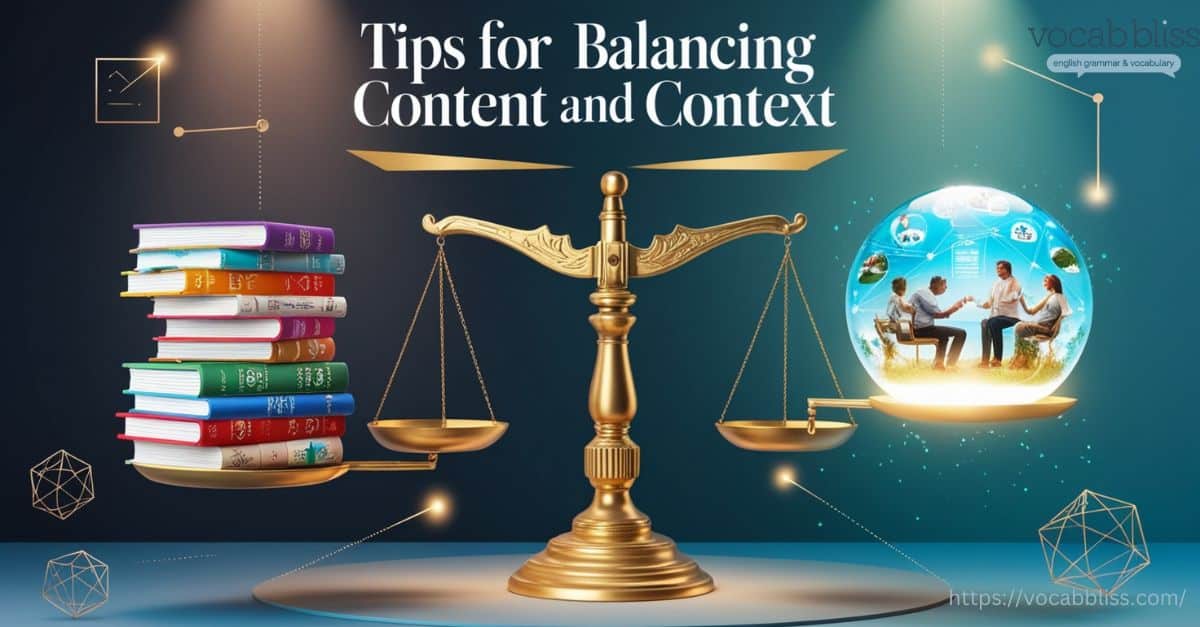
Understanding Your Audience
Tailor your message based on demographics, preferences, and behaviors. Use tools like:
- Surveys
- Analytics platforms
- Real-time feedback
Tailoring Content to Context
- Match the tone to the occasion.
- Use relevant examples and references.
Tools to Help with Contextual Analysis
- Google Analytics: Understand audience behavior.
- Social Media Insights: Track engagement metrics.
Common Mistakes and How to Avoid Them
Ignoring Context
Problem: A company launches a product globally without considering cultural sensitivities.
Solution: Research and adapt for local contexts.
Overloading Context at the Cost of Content
Problem: Adding too much background dilutes the message.
Solution: Focus on clarity and brevity.
The Origins of the Words context or content
Etymology of “Content”
Derived from the Latin contentus, meaning “contained” or “satisfied,” content originally referred to what something holds or contains.
Etymology of “Context”
From the Latin contextus, meaning “woven together,” context emphasizes the interconnectedness of elements in communication.
FAQs About context vs content
What’s the primary difference between content and context?
Content is the message, while context is the background shaping its meaning.
Why is context so crucial in communication?
Context ensures that the message is interpreted correctly by its audience.
How does context influence marketing strategies?
By aligning content with consumer preferences and cultural trends, marketers, therefore, drive better engagement.
Practical Tools and Tips for Better Communication
- Visual Aids: Use diagrams and tables for clarity.
- Real-Time Feedback: Adjust messaging based on audience reactions.
- Collaboration Tools: Align teams on content and context goals.
Conclusion
Understanding the relationship between content vs content is essential for meaningful communication. While content delivers the message, context shapes its interpretation. By balancing both, you can create powerful, engaging messages that resonate with your audience.
Remember: The most successful communication is not just about what you say but how, when, and why you say it.
Dive Deeper:
- Attornies or Attorneys: Which version is correct?
- Truely or Truly: Which One Is Correct?
- Since vs Sense: Mastering the Difference and Usage
- Scraped vs Scrapped? Let’s Eliminate the Confusion

Jorge Phillips is an experienced blogger who writes for Vocab Bliss, sharing his passion for the English language. With a knack for simplifying complex grammar rules and a focus on commonly confused words, Jorge helps readers navigate the nuances of English with ease. His insights aim to make learning engaging and practical.

